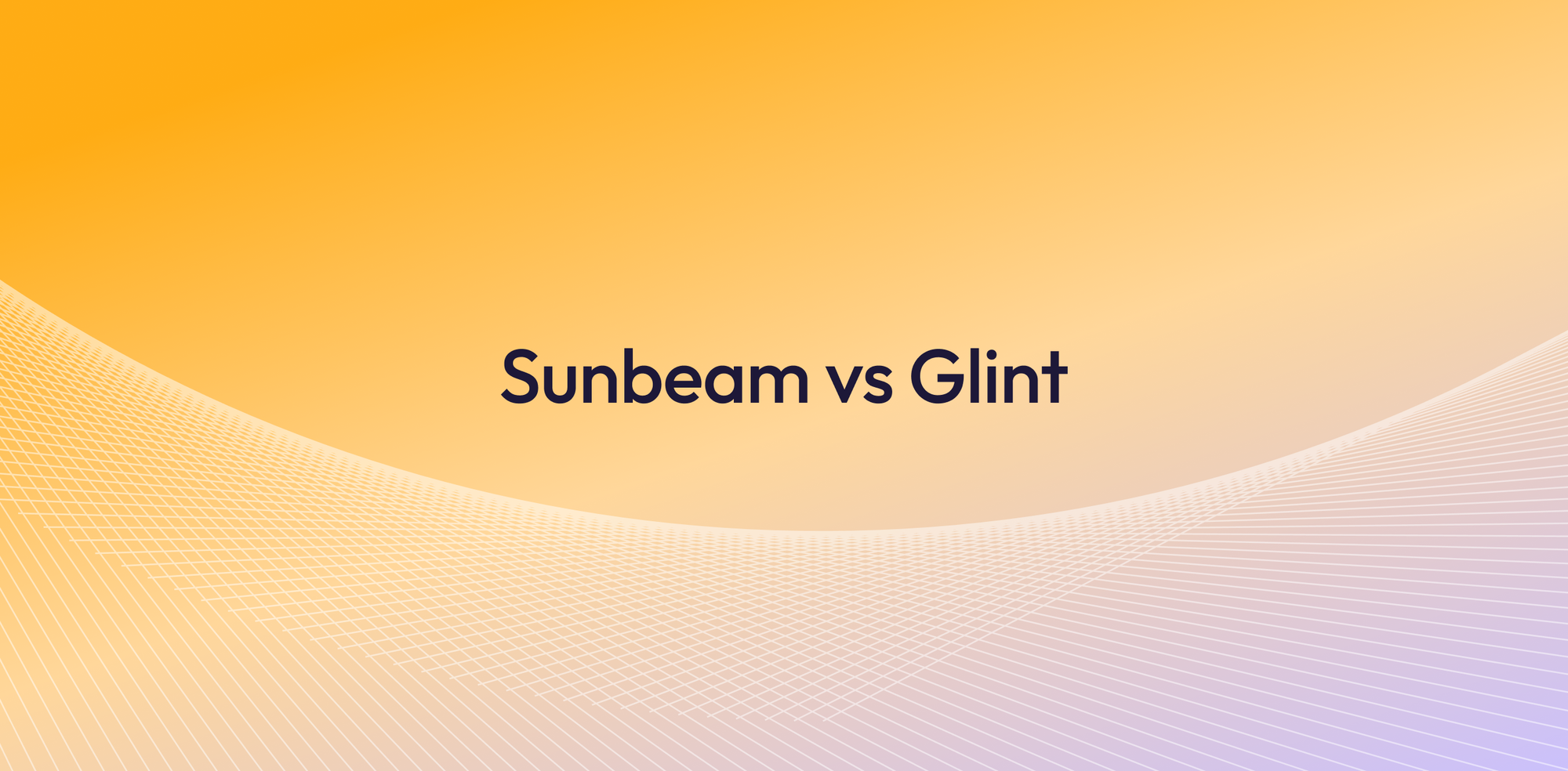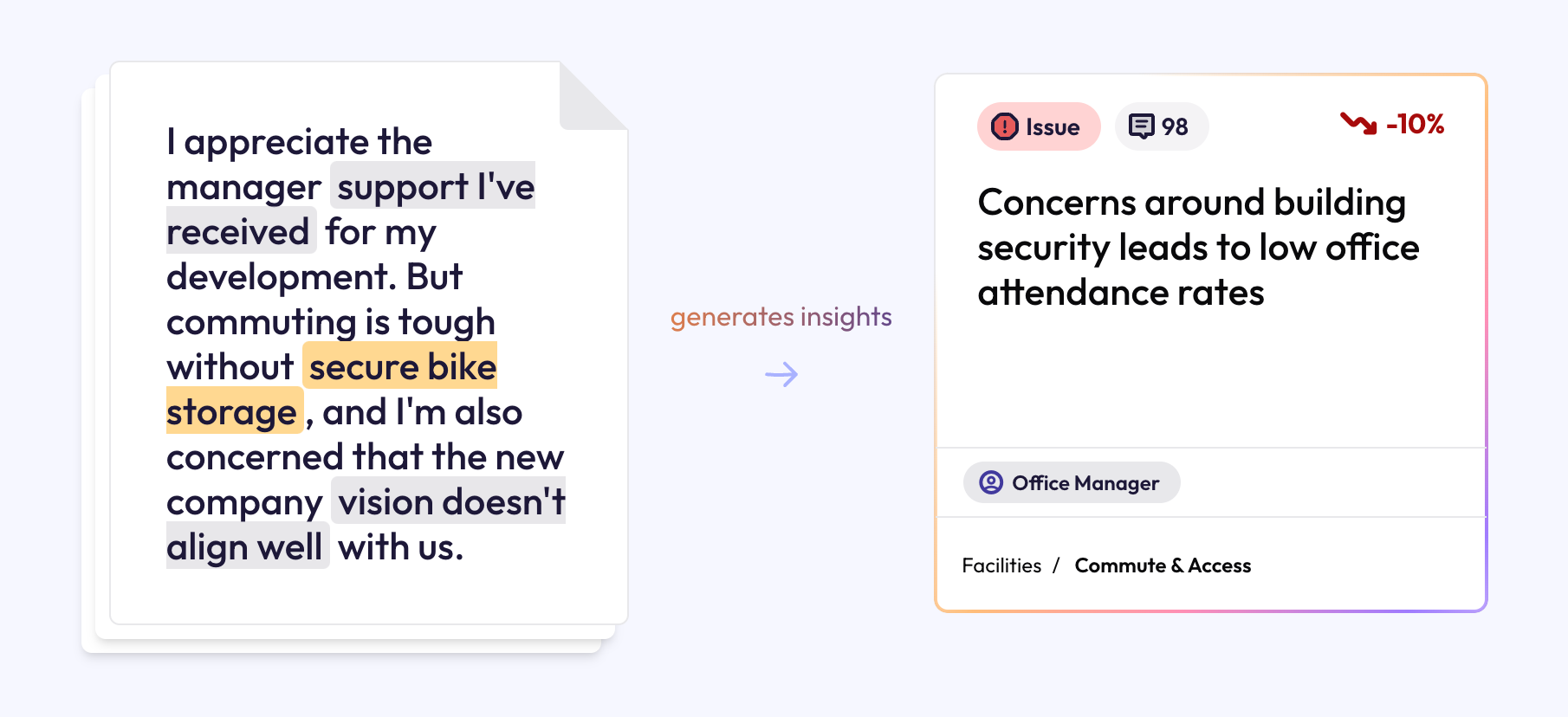Sunbeam vs Glint: Which Platform is Better for Employee Feedback?

Deciding on the right platform to analyse employee feedback can make or break your organisation’s ability to drive meaningful change. Two popular solutions—Sunbeam and Glint — both aim to help businesses understand and act on employee sentiment.
In this article, we’ll compare Sunbeam and Glint, focusing on their approach to feedback analysis, ease of implementation, and the quality of insights they deliver. By the end, you’ll have a clear sense of which tool is best suited to your needs.
What is Sunbeam?
Sunbeam is a feedback analytics platform that specialises in analysing open-ended text responses. By leveraging advanced AI and natural language processing (NLP), Sunbeam identifies specific themes, highlights key issues, and provides actionable recommendations. We all have enough feedback data - it's about what we choose to do with that data that counts.
Designed to work alongside any existing survey tools (such as Qualtrics or Workday), Sunbeam helps HR teams and executives dig deep into qualitative data and transform feedback into clear, prioritised action plans.
What is Glint?
Glint, now owned by Microsoft, is a well-established employee engagement platform. It focuses on tracking engagement metrics, conducting pulse surveys, and analysing sentiment trends. Glint is ideal for organisations looking for a broad, data-driven approach to employee engagement, but its feedback analysis tools often stop short of delivering actionable detail.
Sunbeam vs Glint: A Side-by-Side Comparison
1. Depth of Feedback Analysis
- Glint:
Glint uses basic text analysis to group comments into general categories like "Manager," "Workload," or "Career Progression." While helpful for spotting trends, these broad groupings rarely provide the depth needed to understand root causes or take specific actions. - Sunbeam:
Sunbeam takes analysis a step further by identifying granular themes within feedback. For example, instead of simply flagging "Workload," Sunbeam might uncover:- “Concerns about uneven workload distribution among departments.”
- “Frustration over insufficient staffing during peak periods.”
This level of precision gives HR teams actionable insights that help them tackle the right problems, first time.

2. Prioritising What Matters Most
- Glint:
Glint provides sentiment scores and engagement drivers but leaves users to figure out which issues need attention. This often requires HR teams to manually trawl through comments to determine next steps. - Sunbeam:
Sunbeam ranks issues based on prevalence (how common they are) and importance (their impact on employee engagement). This prioritisation helps organisations focus on high-impact actions without wasting time sifting through thousands of comments. For example, Sunbeam might identify that addressing “inconsistent shift scheduling” will improve engagement for a significant percentage of employees, giving you a roadmap to success.
3. Flexibility and Integration
- Glint:
Glint works best as a standalone platform, meaning organisations must use its survey tools to take full advantage of its features. Integration with external tools is limited. - Sunbeam:
Sunbeam is completely flexible and tool-agnostic. It integrates with existing survey platforms like Qualtrics, CultureAmp, or bespoke systems. Sunbeam also processes data from other sources such as:- Support tickets and customer service interactions.
- Employee exit surveys.
- Ad-hoc feedback projects.
This flexibility ensures Sunbeam fits seamlessly into your current setup while unifying insights across multiple feedback sources.
4. Actionable Recommendations
- Glint:
Glint delivers broad engagement metrics but stops short of telling HR teams how to address the issues it highlights. The onus is on users to interpret the data and determine actions. - Sunbeam:
Sunbeam bridges the gap between data and action by providing specific recommendations for issue it identifies. For instance:- Issue: “Frustration over lack of career development opportunities.”
- Recommendation: “Introduce quarterly career planning sessions and mentorship programmes.”
This feature makes it easy for HR teams to present a concrete plan to senior leadership, helping to drive change quickly.
5. Ease of Implementation
- Glint:
Glint is designed as a comprehensive engagement platform, which can require significant time and resources to implement. This may not suit organisations that already have survey systems in place, or smaller companies looking for a more flexible solution. Glint focuses on analysing data collected using their own survey tool, not on existing data. - Sunbeam:
Sunbeam is quick to implement, with minimal disruption. By integrating directly with your existing tools, Sunbeam delivers value from day one. Its intuitive dashboards and automated insights make it accessible - even for lean HR teams.
6. Pricing and Return on Investment
- Glint:
Glint’s pricing reflects its status as a full-service survey-led engagement platform. While it offers comprehensive features, its higher costs may be prohibitive for smaller organisations or those looking to focus solely on feedback analysis. - Sunbeam:
Sunbeam offers a more cost-effective solution, tailored to organisations that want deeper insights without paying for unnecessary extras. Its prioritised insights and recommendations ensure faster ROI by enabling immediate action.
Who Should Choose Sunbeam?
- Sunbeam is the better choice if:
- You already use an existing survey platform and need advanced feedback analysis to complement it.
- You want actionable insights from open-ended comments, not just broad trends.
- You’re looking for a lightweight, cost-effective solution that delivers immediate value.
- You need to integrate feedback from multiple sources for a holistic view.
Who Should Choose Glint?
- Glint is the better choice if:
- You need an all-in-one engagement platform that starts with a survey.
- Quantitative engagement metrics are your primary focus.
- Your organisation is already embedded in the Microsoft ecosystem (e.g., LinkedIn, Viva, Microsoft Teams).
The Verdict: Sunbeam or Glint?
While Glint excels as a comprehensive engagement platform, its feedback analysis tools can feel too broad for organisations seeking deeper insights. Sunbeam, on the other hand, provides a laser-focused approach to feedback analysis, delivering detailed, prioritised, and actionable insights that HR teams can use to drive meaningful change.
If your organisation values precision, flexibility, and speed of implementation, Sunbeam is the clear choice.
Ready to See the Difference?
Book a demo of Sunbeam today and discover how it can transform your approach to employee feedback.
